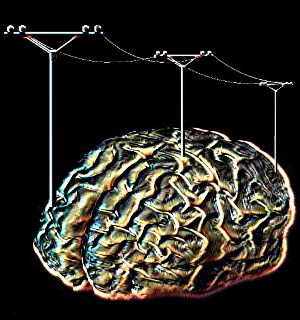Brain sections sing rapid thoughts in harmony
 The brain is an incredible processing tool that can jump from thought to thought almost instantly, and a new study says the ability to think quickly may come from harmony between regions.
The brain is an incredible processing tool that can jump from thought to thought almost instantly, and a new study says the ability to think quickly may come from harmony between regions.
Learning new things causes our brains to create new physical links, but a recent study has shown that separate regions can actually synchronise their processes without needing a direct connection.
Researchers have observed two normally separate parts of the brain giving off a matching set of brainwaves when they work together.
Authors of the new study say this could be an ad-hoc way of combining different mental processes for momentary needs.
They say that if the two neural regions synchronise long enough, then a physical link (synapse) is formed.
Researchers in the US have observed that as monkeys learn to categorise different patterns of dots, two brain areas involved in learning — the prefrontal cortex and the striatum — synchronise their brain waves to form new communication circuits on the fly.
The finding may explain how parts of the brain are able to work in harmony despite not having a direct connection, and may guide ‘synaptic plasticity’ – the process of forming those neural links.
“If you can change your thoughts from moment to moment, you can't be doing it by constantly making new connections and breaking them apart in your brain. Plasticity doesn't happen on that kind of time scale,” says Dr Earl Miller from MIT.
“There's got to be some way of dynamically establishing circuits to correspond to the thoughts we're having in this moment, and then if we change our minds a moment later, those circuits break apart somehow. We think synchronized brain waves may be the way the brain does it.”
Miller’s team wanted to investigate whether this activity pattern actually reflects communication between the prefrontal cortex and striatum, or if each region is working independently. To do this, they measured EEG signals as monkeys learned to assign patterns of dots into one of two categories.
In the early stages, the animals could simply memorise which examples belonged to each category.
However, the number of exemplars eventually became too large for the animals to memorise, and they began to learn the general traits that characterised each category.
By the end of the experiment, when the researchers were showing 256 different examples, the monkeys were able to categorise all of them correctly.
As the monkeys shifted from rote memorisation to learning the categories, the researchers saw a corresponding shift in brain patterns.
Brain waves known as “beta bands”, produced independently by the prefrontal cortex and the striatum, began to synchronize with each other. This suggests that a communication circuit is forming between the two regions, Miller says.
“There is some unknown mechanism that allows these resonance patterns to form, and these circuits start humming together,” he said.
“That humming may then foster subsequent long-term plasticity changes in the brain, so real anatomical circuits can form. But the first thing that happens is they start humming together.”
Later on, as an animal nailed down the two categories, two separate circuits formed between the striatum and prefrontal cortex, each corresponding to one of the categories.
The researchers are now looking at how the brain learns more abstract categories, and how activity in the striatum and prefrontal cortex might reflect that type of abstraction.








 Print
Print